Hybrid Systems
Hybrid Systems represent one of the most fascinating categories within the Xenophysiology Classification System, encompassing life forms that successfully combine multiple primary metabolic strategies. These organisms demonstrate remarkable adaptability through their ability to utilize various energy sources and biological processes simultaneously.
 Anatomical diagram showing the integrated metabolic pathways of a Thermoelectric Arthropod species
Anatomical diagram showing the integrated metabolic pathways of a Thermoelectric Arthropod speciesCharacteristics
Hybrid Systems typically demonstrate at least two distinct metabolic processes working in conjunction. Common combinations include:
-
Photochemical processing paired with conventional molecular metabolism
-
Bioelectric energy generation alongside thermal regulation systems
-
Radiotropic absorption combined with chemical synthesis
Notable Examples
Thermoelectric Arthropods
These creatures, first discovered in the Sigma Nebula, possess both conventional digestive systems and specialized organs capable of converting thermal gradients into bioelectric energy. This dual-system approach allows them to survive in extreme temperature variations.
 Thermal imaging showing active energy conversion in a Thermoelectric Arthropod colony
Thermal imaging showing active energy conversion in a Thermoelectric Arthropod colonyPhotosynthetic Predators
The Chlorovore species represents a unique combination of autotrophic and heterotrophic systems. These organisms can sustain themselves through both photosynthesis and the consumption of prey, switching between energy sources based on environmental conditions.
Environmental Advantages
The ability to utilize multiple metabolic pathways provides Hybrid Systems with several evolutionary advantages:
-
Enhanced survival in varying environmental conditions
-
Reduced dependency on single energy sources
-
Improved adaptation to seasonal changes
-
Greater resilience during resource scarcity
Research Applications
The study of Hybrid Systems has led to numerous breakthroughs in:
-
Bioengineering Applications
-
Sustainable energy development
-
Adaptive Medical Treatments
Classification Challenges
The complexity of Hybrid Systems poses unique challenges for taxonomists. The Metabolic Integration Scale was developed specifically to address the classification of organisms with multiple primary metabolic strategies.
Current Research
Recent studies focus on:
-
Mapping energy conversion efficiency in hybrid organisms
-
Understanding the evolution of multiple metabolic pathways
-
Developing applications for Synthetic Biology
See Also
- Metabolic Integration Scale
- Bioengineering Applications
- Thermoelectric Arthropod
References
- Journal of Complex Metabolic Systems
- Hybrid Organism Research Quarterly
- Advanced Xenobiology Review